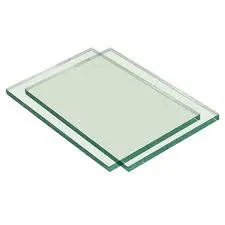Tinted glass is a versatile and essential component found in numerous industries, ranging from automotive to architecture. Understanding the different types of tinted glass and their applications can enhance decision-making processes for businesses seeking to improve both aesthetics and functionality. This article delves into various types of tinted glass, emphasizing their unique attributes and advantages.

1. Dyed Tinted Glass
Dyed tinted glass is one of the most common forms used in both residential and commercial settings.
The manufacturing process involves the addition of a dye to the molten glass. This dye absorbs solar radiation, reducing glare and heat ingress while maintaining privacy. It’s particularly beneficial for building facades and automobile windows, where reducing UV penetration can significantly enhance occupant comfort and protect interior materials from fading.
2. Metal Oxide Coated Glass
This type of tinted glass involves the application of a metal oxide coating to one side of the glass. The coating reflects heat while allowing natural light to pass through, achieving superior thermal efficiency. Architects often prefer metal oxide-coated glass in modern designs, where energy efficiency and sleek aesthetics are priorities. This glass type also complies with green building standards, making it an authoritative choice for eco-friendly projects.

3. Reflective Tinted Glass
Reflective tinted glass, similar to metal oxide-coated glass, features a thin metallic layer that imparts a mirror-like finish to the glass surface. This enhances privacy during the daytime and simultaneously reduces solar heat gain, thus contributing to a building’s energy efficiency. The reflective properties make it ideal for high-rise buildings where controlling sunlight and external visibility is crucial.
4. Photochromic Glass
Photochromic tinted glass is engineered to dynamically adjust its tint level in response to sunlight intensity. Often used in eyewear and smart building technologies, this glass type ensures optimal comfort by automatically changing from clear to tinted during bright conditions. While still an emerging trend in larger architectural projects, photochromic glass represents a cutting-edge solution where adaptability and user comfort converge.
types of tinted glass
5. Thermochromic Glass
Similar to photochromic glass, thermochromic glass responds to temperature variations rather than light. Altering its tint based on the ambient temperature, it can regulate heat gain and glare effectively. This type of glass is especially beneficial in climates with extreme temperature fluctuations, offering energy savings and enhanced indoor comfort. Its ability to maintain indoor climate control without sacrificing natural light makes it an authoritative choice in smart building applications.
6. Ceramic Frit Tinted Glass
Ceramic frit glass uses ceramic compounds baked onto the glass surface, producing varied patterns and colors. Widely used in decorative applications and where uniform appearance or specific color aesthetics are desired, ceramic frit glass balances functionality with artistic expression. This glass also enhances safety as the frit provides increased shatter resistance, thus offering trustworthiness as a structural material.
Experts in the field consistently emphasize the importance of selecting the right type of tinted glass based on project-specific requirements. Consulting with industry professionals can safeguard against common pitfalls, such as inadequate UV protection or improper thermal performance. Established manufacturers continue to innovate, bringing forth new products that redefine the possibilities of tinted glass.
In conclusion, each type of tinted glass carries distinct advantages and is designed for specific applications. Professionals looking to integrate tinted glass into their projects should prioritize understanding these differences. By leveraging expert knowledge and authoritative guidance, one can optimize their choice, ensuring that aesthetic goals align seamlessly with functional demands, thereby enhancing both product lifespan and user satisfaction.
 Afrikaans
Afrikaans  Albanian
Albanian  Amharic
Amharic  Arabic
Arabic  Armenian
Armenian  Azerbaijani
Azerbaijani  Basque
Basque  Belarusian
Belarusian  Bengali
Bengali  Bosnian
Bosnian  Bulgarian
Bulgarian  Catalan
Catalan  Cebuano
Cebuano  Corsican
Corsican  Croatian
Croatian  Czech
Czech  Danish
Danish  Dutch
Dutch  English
English  Esperanto
Esperanto  Estonian
Estonian  Finnish
Finnish  French
French  Frisian
Frisian  Galician
Galician  Georgian
Georgian  German
German  Greek
Greek  Gujarati
Gujarati  Haitian Creole
Haitian Creole  hausa
hausa  hawaiian
hawaiian  Hebrew
Hebrew  Hindi
Hindi  Miao
Miao  Hungarian
Hungarian  Icelandic
Icelandic  igbo
igbo  Indonesian
Indonesian  irish
irish  Italian
Italian  Japanese
Japanese  Javanese
Javanese  Kannada
Kannada  kazakh
kazakh  Khmer
Khmer  Rwandese
Rwandese  Korean
Korean  Kurdish
Kurdish  Kyrgyz
Kyrgyz  Lao
Lao  Latin
Latin  Latvian
Latvian  Lithuanian
Lithuanian  Luxembourgish
Luxembourgish  Macedonian
Macedonian  Malgashi
Malgashi  Malay
Malay  Malayalam
Malayalam  Maltese
Maltese  Maori
Maori  Marathi
Marathi  Mongolian
Mongolian  Myanmar
Myanmar  Nepali
Nepali  Norwegian
Norwegian  Norwegian
Norwegian  Occitan
Occitan  Pashto
Pashto  Persian
Persian  Polish
Polish  Portuguese
Portuguese  Punjabi
Punjabi  Romanian
Romanian  Russian
Russian  Samoan
Samoan  Scottish Gaelic
Scottish Gaelic  Serbian
Serbian  Sesotho
Sesotho  Shona
Shona  Sindhi
Sindhi  Sinhala
Sinhala  Slovak
Slovak  Slovenian
Slovenian  Somali
Somali  Spanish
Spanish  Sundanese
Sundanese  Swahili
Swahili  Swedish
Swedish  Tagalog
Tagalog  Tajik
Tajik  Tamil
Tamil  Tatar
Tatar  Telugu
Telugu  Thai
Thai  Turkish
Turkish  Turkmen
Turkmen  Ukrainian
Ukrainian  Urdu
Urdu  Uighur
Uighur  Uzbek
Uzbek  Vietnamese
Vietnamese  Welsh
Welsh  Bantu
Bantu  Yiddish
Yiddish  Yoruba
Yoruba  Zulu
Zulu 


